Black Ladybugs With Red Spots (With Pictures) – Identification Guide
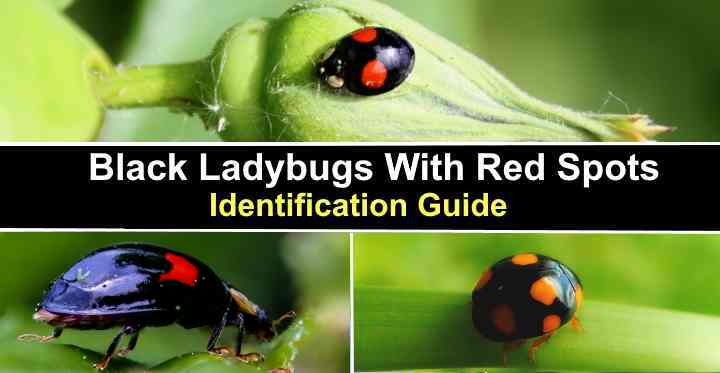
Black ladybugs with red spots are relatively common. Of course, red-spotted black ladybugs are not as common as red ladybugs. But you can find black ladybugs on shrubs, flowers, and other plants in your yard if you look hard enough. Common types of black ladybugs with red spots include the twice-stabbed ladybug, harlequin ladybug, and pine ladybug.
Identifying black ladybugs with red dots is relatively straightforward. Typically, you can tell the type of black beetle by the number of red spots on its black elytra (wing covers). Also, most black ladybugs are relatively small. So identifying them by counting the spots is usually the best method.
This article is an identification guide to black ladybugs with red spots. Pictures and descriptions of the red-spotted black beetles will help you know the type you have found.
Why Are Some Ladybugs Black?
Some ladybugs are black as a deterrent against predators. The red spots of their shiny black wing covers could help prevent birds and insects from trying to eat them. It could be that the contrast of the bright crimson dots against the shiny black surface acts as a warning signal to would-be predators.
Black ladybugs are a type of black beetle in the family Coccinellidae. Identifying characteristics of the black “bugs” are their domed shape, two pairs of wings, six legs, compound eyes, and two antennae. Most black ladybugs have red spots; however, some may have different markings.
Related reading: Ladybug life cycle.
Types of Black Ladybugs with Red Spots
Let’s look in more detail at the different kinds of black ladybugs with red spots.
Twice-Stabbed Ladybug (Chilocorus stigma)
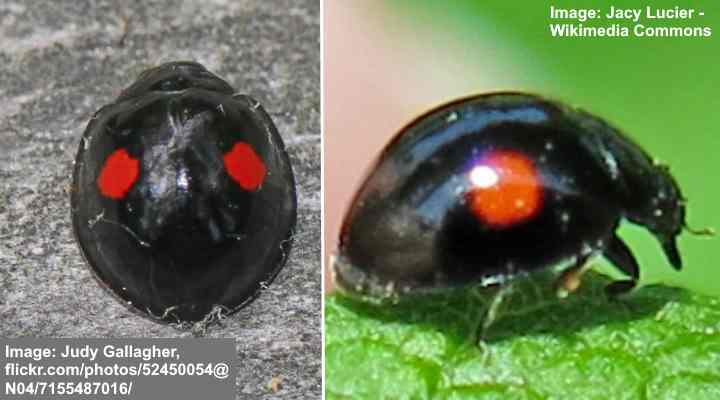
The twice-stabbed ladybug is identified by its black body and two red spots and is common in North America
The twice-stabbed ladybug is an eye-catching black ladybug with two red spots on its back. The easily identifiable feature of this shiny black beetle is the single dot on each elytron. The twice-stabbed ladybug measures 0.14” to 0.20” (3 – 5 mm). It is one of the most common red-spotted black beetles in North America.
The twice-stabbed ladybug is usually found on plants like roses, sunflowers, marigolds, and pine forests. The black and red beetle feeds on scale insects, mealybugs, and aphids, making it a highly beneficial insect for pest control. Like most ladybugs, the insect lives for up to one year and overwinters in plant debris.
Harlequin Ladybug (Harmonia axyridis)
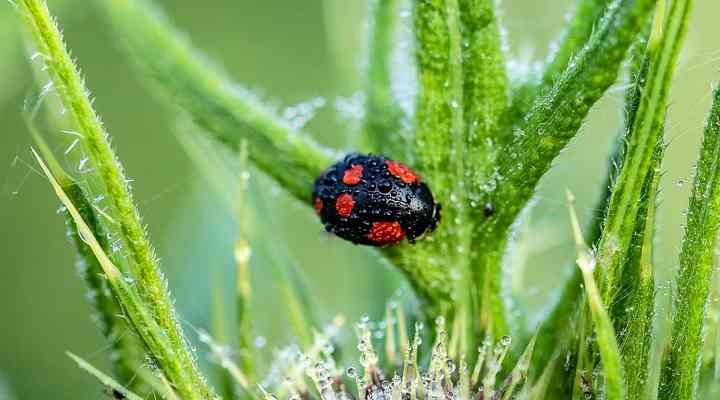
Harlequin ladybugs have a black body with red spots that vary according to the subspecies
Also called the Asian ladybeetle, the harlequin ladybug is a black beetle with several red markings. Great variation exists in the species. Some black harlequin beetles have large, round red spots, C-shaped markings, or bright red markings like the letter W. Harlequin ladybugs grow 0.21” to 0.31” (5.5 – 8.5 mm).
It can be tricky to identify species of Asian ladybugs because some can be red with black dots, yellow, or entirely black. In addition, the undersides of the winged insects are dark with a broad reddish-brown margin.
Black harlequin ladybugs with red spots are an invasive species and can become a nuisance in homes. Unlike native black ladybugs, the Asian varieties have a tendency to bite and emit a foul, yellow-staining odor when squashed. Although they help control aphid populations, they can invade homes in late fall.
These non-native black and red ladybugs are challenging to identify because they look similar to harmless, native ones. The best way to differentiate between them is to look at the markings on their heads. The native ladybugs have a white M or W marking on their head.
Black Harlequin Ladybug with Two Red Spots (Harmonia axyridis conspicua)

Black harlequin conspicua ladybug can be recognized by its black body, two large red spots on its wing covers and white spots on its head
The black harlequin ladybug of the conspicua form is a black beetle with two red spots. These dark red markings are relatively large on the rounded elytra and sometimes have a distinctive C shape. However, some of these black ladybugs have a single orange or yellow spot on the wing covers.
The other type of red-spotted harlequin ladybug is the Harmonia axyridis spectabilis. This invasive black beetle has shiny black domed wing covers with a pair of red spots on each elytron, making it a four-spotted black ladybug.
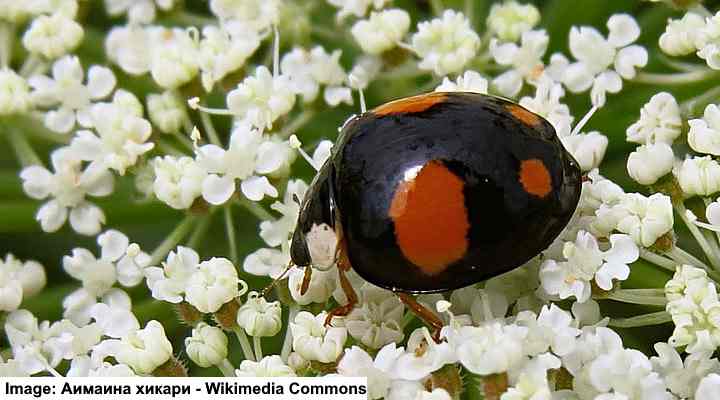
Black harlequin spectabilis ladybug has four red spots on its black body
Pine Ladybug (Exochomus quadripustulatus)
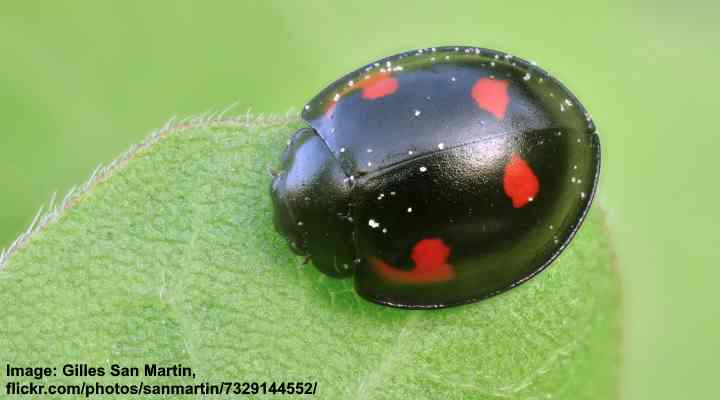
The pine ladybug has distinctive red markings on its shiny black body
The pine ladybug is a native type of ladybug with shiny black wing covers and distinctive red markings. The identifying feature of the ladybird markings is the comma-shaped spots together with small oval or round dots. In most species, they are reddish-brown. However, some ladybugs may have orange or yellow marks.
Pine ladybugs measure 0.16” to 0.23” (4 – 6 mm) long. The shiny black insects are almost entirely round with a striking appearance of jet-black elytra and contrasting red markings. From April to October, you will find pine ladybugs in deciduous and coniferous forests.
Heather Ladybug (Chilocorus bipustulatus)

The heather ladybug can be identified by its red spots in a row on a black body
The heather ladybug is a common black beetle with red spots you can find in fruit gardens and pine forests. The small black ladybug’s identifiable features are its shiny black elytra with two reddish-orange spots on each side. Sometimes, the ladybugs have three small spots in a straight line.
Heather ladybugs measure 0.12” to 0.20” (3 – 5 mm) long. Like many ladybugs that are classed as beneficial insects, they feed on aphids and scale insects. In some countries, this ladybug species is used for pest control in citrus fruit orchards. In summer and fall, you will commonly find them on low-growing vegetation and grasses.
Kidney-Spot Ladybug (Chilocorus renipustulatus)
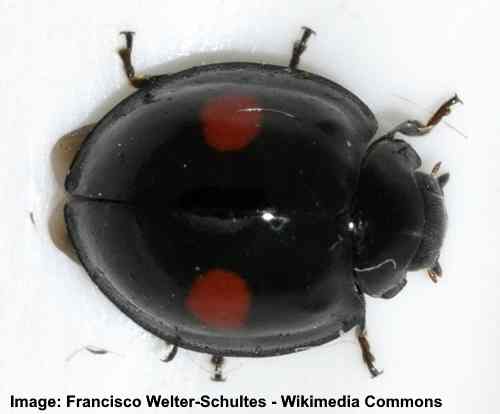
The kidney-spot ladybug with its 2 red spots on a black body consumes mostly scale insects
The kidney-spot ladybug is a small black beetle with two large red spots on its shiny wing covers. Apart from the two large reddish dots, an identifying feature of the small, black beetle is the flattened flange around its side. These red-spotted black ladybugs grow up to 0.20” (5 mm) long.
You will often find kidney-spot ladybugs in deciduous forests from spring through fall. Its primary food source is scale insects.
Like all ladybugs, the insect starts its life cycle as a tiny egg. After hatching, the ladybug larvae look like spiky black or dark brown caterpillars. Then after pupating, the adults emerge in early spring and live for about 12 months.
Two-Spot Ladybug (Adalia bipunctata)
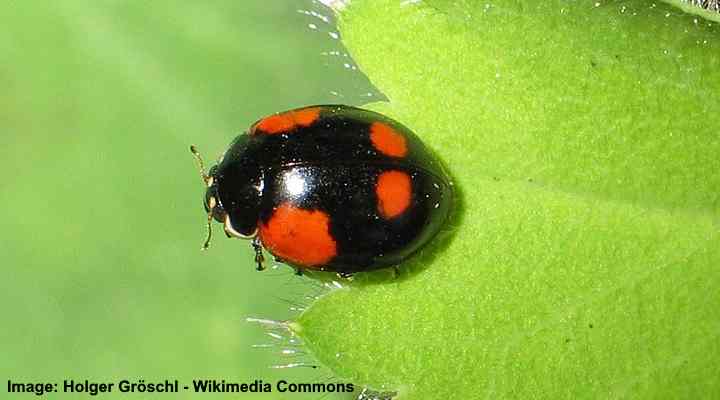
The two-spot ladybug can have 2 to 6 red spots on its black body, depending on the subspecies
The two-spot ladybug is an eye-catching black insect with two, four, or six red dots on its back. Although commonly called the two-spot ladybug, variations of the species have more dots. For example, the quadripustulata form is the four-spot melanic ladybug—black with four red spots. And the sexpustulata is shiny black with six red spots.
The eye-catching coloring of the two-spot ladybug makes this small ladybug stand out on plant foliage. The ladybug measures 0.16” to 0.20” (4 – 5 mm) long. It feeds on aphids, mealybugs, and other garden pests. It’s commonly found in woodlands, parks, and grasslands.
10-Spot Ladybug (Adalia decempunctata)
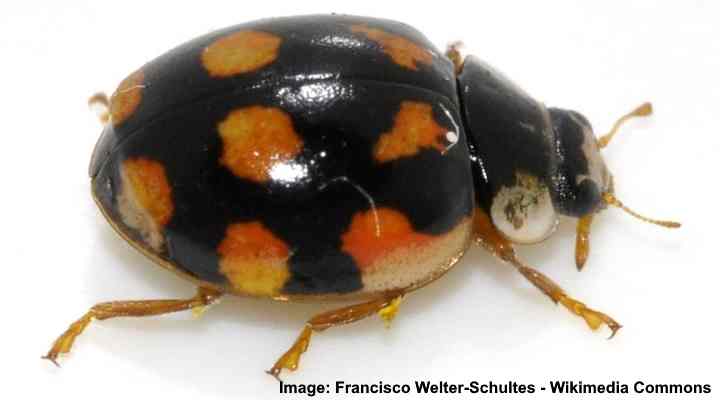
The 10-spot ladybug has five orange-red spots on each black wing cover
The 10-spot ladybug is a small flying creature that can be black and red, brown and cream, or orange and black. The decempunctata form of the species has a shiny, jet-black body with large orange-red markings on its elytra. There can be red spots and curved markings on each wing cover.
Despite its name, not all species of these ladybugs have ten spots on their backs. Generally, the oval black ladybugs with reddish markings are 0.14” to 0.77” (3.5 – 4.5 mm) long.
Common plants where you will find black 10-spot ladybugs include deciduous trees, pines, hedgerows, and coastal dune systems. They typically feed on aphids, making them beneficial insects for greenhouses.
Four-Spotted Ladybug (Brachiacantha quadripunctata)
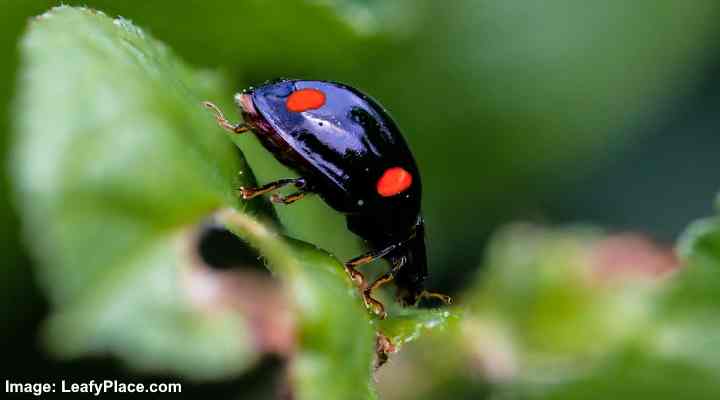
The four-spotted red and black ladybug is found in North America and is common in mid summer and early fall
As its name suggests, the four-spotted ladybug is a black beetle with a pair of bright red spots on each wing cover. Distinguishing features of this shiny black beetle are its four spots, six brown legs, and tiny antennae. The red-spotted shiny black ladybugs measure 0.01” to 0.17” (2.5 – 4.5 mm) long.
Interestingly, some variations of Brachiacantha quadripunctata only have two spots—a single spot on each wing cover. This fact makes the ladybugs easy to confuse with the two-spotted ladybug, sigil ladybug, or spurleg lady beetle. The black ladybugs are common in mid-summer and early fall.
Cactus Ladybug (Chilocorus cacti)

The cactus ladybug has 2 large red spots on its black round body and is commonly seen on cacti
Also called the twice-stabbed cactus ladybug, this species is a black ladybug with two red spots. The domed ladybugs have a round shape and measure 0.24” (6 mm) long. The two vibrant reddish-brown spots contrast with the shiny black wing covers. Its common name, “twice-stabbed ladybug,” refers to the two red spots.
As its name suggests, this red-spotted black ladybug is often found on cacti. Like most predatory black ladybugs, the insects feed on aphids and scale insects. Because of its similar appearance, the ladybug is easily confused with the two-stabbed ladybug Chilocorus stigma.
Twice-Struck Ladybug (Axion Plagiatum)
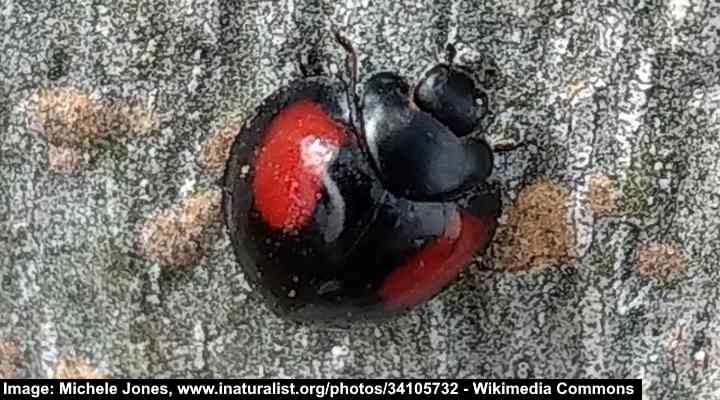
The 2 red spots on the twice-struck ladybug are larger compared to other ladybug types
The twice-struck ladybug is easily recognizable by its shiny black body and two conspicuous red spots on its back. The two large round marks are on heart-shaped wing covers on either side, just below the pronotum. The ladybug has a smooth, shiny body that ranges in size from 0.23” (6 mm) long.
The larvae of the twice-struck ladybug are mostly black with brown and orange markings and a spiny body. The larvae and adults feed on aphids and other soft-bodied pests. Additionally, the black and red adults feed on pollen and flower nectar.
The two red spots on the shiny black domed wing covers make this species hard to tell apart from two-stabbed ladybugs or two-spot ladybugs. However, comparing the types of ladybugs, it’s clear that the red spots on the black Axion Plagiatum are larger than the other species.
Three-Spotted Ladybug (Axion tripustulatum)

The three-spotted ladybug has 2 reddish marks on the sides and additional one on the tail end
The three-spotted ladybug is a small round black ladybug with a matte finish and three reddish-brown markings on its back. The two stripe-like markings are on the sides near the head and one small red dot at its tail end. The three-spotted ladybug is 0.20” to 0.27” (5 – 7 mm) long.
Bigeminate Sigil Ladybug (Hyperaspis bigeminata)

The bigeminate sigil ladybug is entirely black apart from 2 red spots on either side of its head and additional 2 at the rear end
The native bigeminate sigil ladybug is a small shiny black beetle with orange-red spots on its wing covers and pronotum. In addition, each of the bug’s black elytra has a single red spot towards the rear end and one on either side of its head. The tiny red and black ladybugs measure 0.09” to 0.13” (2.3 – 3.4 mm) long.
Up close, pictures of this small black ladybug reveal its elytra is slightly pitted. Other characteristics of the black beetle are its brown legs and tan-brown patch on its head. But, apart from that, the ladybug is entirely black.
Kuwana’s Ladybug (Chilocorus kuwanae)
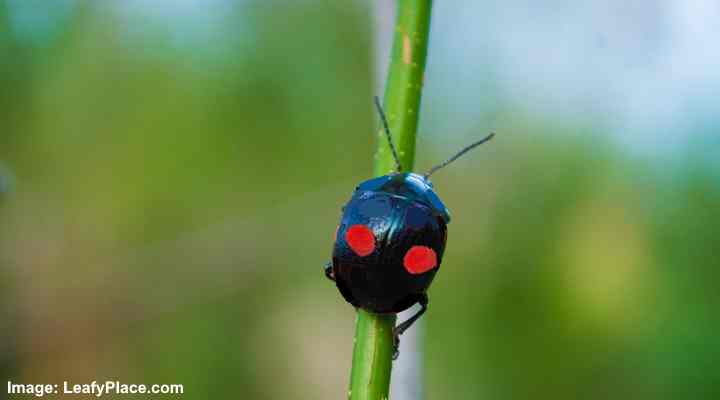
The deep red spots of the Kuwana’s ladybug are located on the center of its black body
Kuwana’s ladybug is a black beetle with two red spots on the center of its wing covers. It’s completely black with a round shape, glossy wing covers, and two deep red round marks on its wing covers. Non-native Kuwana ladybugs only measure 0.12” (3 mm) long.
Kuwana’s ladybug is a beneficial insect to control scale insects on wintercreeper plants. The ladybug’s spine-covered brown larvae can eat hundreds of scale insects before pupation. After emerging as a black ladybug, the adults continue feeding on wintercreeper scale. However, the adults also feed on flower pollen and nectar.
Hieroglyphic Ladybug (Coccinella hieroglyphica)
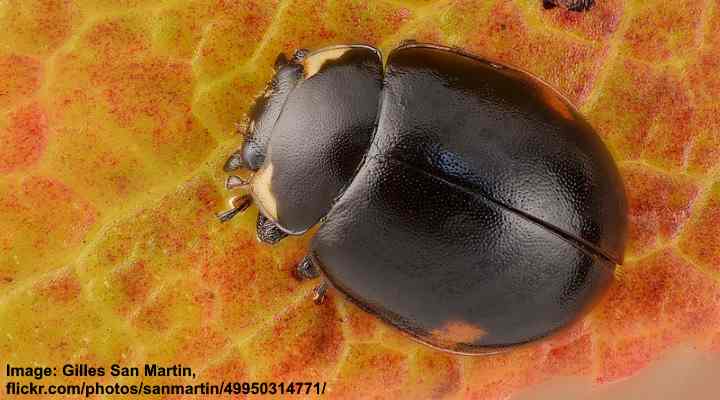
The hieroglyphic ladybug is identified by its red marks on either side of the body and whitish marks near the head
The hieroglyphic ladybug is almost completely black, apart from a small red mark on either side of its wing covers. The small black flying insect measures 0.16” to 0.20” (4 – 5 mm) long and has an oval body. Some variations of the species are light, chestnut brown ladybugs with black spots. However, the ladybugs have black legs in all the color variations.
You often find hieroglyphic ladybugs on grasslands, mixed forests, and marshes, especially where heather grows. However, the black ladybugs also frequent birch, willow, pine, and birch trees.
Are Black Ladybugs with Red Spots Poisonous?
Many species of black ladybugs with red sports are poisonous. Research into the coloration of various ladybug species found that black ladybugs with red markings are the most toxic. Therefore, it’s common for these black and red beetles to leave behind a yellowish-red fluid that has a musky, unpleasant smell.
However, it’s good to note that black ladybugs with red spots do not harm humans. On the contrary, many species benefit your garden and can help with pest control. These little bugs feed on aphids and other soft-bodied pests, so encouraging them in your yard is a good idea.
Do Black Ladybugs Bite?
Ladybugs can bite, but they only leave a tiny mark. However, it’s so rare for the small flying beetles to bite humans that they are considered completely harmless. Also, they do not inject venom. Therefore, there is nothing to fear from native black ladybugs with red-spotted wing covers.
However, when it comes to Asian ladybugs (Harmonia axyridis), it’s a different story. The invasive harlequin ladybugs can bite and invade homes in large numbers in the fall. In addition, some studies have found that these black and red ladybugs can cause allergic reactions that result in sneezing, a runny nose, or difficulty breathing.
What Do Black Ladybugs Eat?
Like other species of ladybugs, black ladybugs are important natural pest control creatures for your garden. They feast on small, soft-bodied insects such as aphids, mealybugs, small spiders, scale insects, and other soft-bodied invasive pests. These tiny black beetles can consume thousands of aphids in their lifetime. Therefore, they can help keep the population of these garden pests under control.
Additionally, ladybugs also feed on pollen and nectar from flowers. Consequently, they also help pollinate plants as they fly from plant to plant. Because they don’t go looking for nectar, they are accidental pollinators.
Ladybug larvae are also important pest control insects. Like the adults, the spiky, alligator-like crawling insects feed mainly on aphids. Therefore, encouraging all types of ladybugs—apart from invasive Asian species—can benefit your garden landscape.
Related articles:
